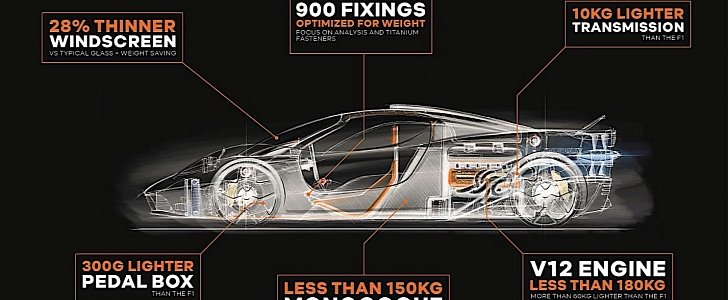One of the men behind the world’s greatest supercar, the McLaren F1, is back at it. After spending several years pondering what may be considered the first true successor to the F1, the South African finally decided to go for it and last year announced the T.50.
Targeting a weight of just 980 kg (2,160 pounds), the T.50 should become the world’s lightest supercar, because as Murray says, “a heavy car can never deliver the dynamic attributes of a lighter one.” And with the reduced weight come some interesting numbers.
In an attempt to explain why lighter is better, Murray crunched in the numbers and released the results of the math this week, just to keep us focused on the matter. He based his comparison chart on an average weight for a supercar of 1,436 kg (3,166 pounds).
When it arrives sometime in 2022, the T.50 will hit the road with a naturally aspirated Cosworth 3.9-liter engine in V12 configuration. Described as the highest-revving road car engine ever made (12,100 rpm) it should develop 650 hp as standard, occasionally boosted by a 48-volt integrated starter-generator to 700 hp.
Applying those numbers to the weight of the vehicle means every 100 horsepower would have to move along 150 kg (330 pounds) of car, as opposed to the 210 kg (463 pounds) the same troop needs to move on an average supercar.
The low weight of the car was achieved – or will be, as we are yet to see an actual, real life prototype - by making extensive use of carbon fiber on pretty much everything from the body panels to the three seats fitted inside.
The whole monocoque-body panels assembly weighs under 150 kg (331 pounds): the engine has been tweaked into weighing less than 180 kg (397 pounds) – the lightest road-going V12 ever made according to Gordon Murray.
What’s more, the weight of “every part, down to nuts, bolts and washers” is discussed by the engineering team in weekly meetings.
“Designing a lightweight sports car does not come from specifying exotic materials alone, it comes from a state of mind, from absolute focus and control, and from a deep understanding of lightweight, optimised design,” Murray said.
We'll just have to wait and see if the hype created around this car is worth it, but knowing Murray's work, it most likely will.
In an attempt to explain why lighter is better, Murray crunched in the numbers and released the results of the math this week, just to keep us focused on the matter. He based his comparison chart on an average weight for a supercar of 1,436 kg (3,166 pounds).
When it arrives sometime in 2022, the T.50 will hit the road with a naturally aspirated Cosworth 3.9-liter engine in V12 configuration. Described as the highest-revving road car engine ever made (12,100 rpm) it should develop 650 hp as standard, occasionally boosted by a 48-volt integrated starter-generator to 700 hp.
Applying those numbers to the weight of the vehicle means every 100 horsepower would have to move along 150 kg (330 pounds) of car, as opposed to the 210 kg (463 pounds) the same troop needs to move on an average supercar.
The low weight of the car was achieved – or will be, as we are yet to see an actual, real life prototype - by making extensive use of carbon fiber on pretty much everything from the body panels to the three seats fitted inside.
The whole monocoque-body panels assembly weighs under 150 kg (331 pounds): the engine has been tweaked into weighing less than 180 kg (397 pounds) – the lightest road-going V12 ever made according to Gordon Murray.
What’s more, the weight of “every part, down to nuts, bolts and washers” is discussed by the engineering team in weekly meetings.
“Designing a lightweight sports car does not come from specifying exotic materials alone, it comes from a state of mind, from absolute focus and control, and from a deep understanding of lightweight, optimised design,” Murray said.
We'll just have to wait and see if the hype created around this car is worth it, but knowing Murray's work, it most likely will.





